Abstract
This paper addresses the synchronization problem in complex networks characterized by short-memory fractional dynamics and directed higher-order interactions. Sufficient conditions for global synchronization are rigorously derived using Lyapunov-based analysis and an effective pinning control strategy. To further enhance the adaptability and robustness of the network, an adaptive control law is constructed, accommodating uncertainties and time-varying coupling strengths. An improved predictor–corrector numerical algorithm is also proposed to efficiently solve the underlying short-memory systems. A numerical simulation is conducted to demonstrate the validity of the proposed theoretical results. This work deepens the theoretical understanding of synchronization in higher-order fractional networks and provides practical guidance for the design and control of complex systems with short-memory and higher-order effects.
1. Introduction
Networks have become essential tools for studying complex systems and are typically represented by structures of nodes and edges [1]. Traditional networks, however, focus solely on pairwise relationships, limiting their ability to capture the group interactions common in social [2], biological, and technological contexts [3]. To overcome this limitation, higher-order networks such as hypergraphs and simplicial complexes have been developed, which capture multi-node relationships and thus offer a richer, more accurate framework for analyzing complex dynamics [4,5,6]. Various studies have made significant progress in modeling and analyzing collective dynamics and spreading processes on such higher-order structures [7].
Fractional calculus is known for its long-term memory effect, as the present state always depends on the entire history of the function [8]. For example, the Riemann–Liouville derivative integrates all past values , making numerical computation costly and complex [9]. However, for large times, the influence of the distant past can often be neglected—a concept referred to as the “principle of dissipation of hereditary action” [10]. To address the computational challenges, Podlubny introduced the short-memory principle, which approximates fractional derivatives by considering only the recent history , significantly improving efficiency [11]. Studies indicate that short-memory fractional derivatives are better suited for modeling systems exhibiting short-term memory effects, including impulse systems [12], neural networks [13], memristors [14,15], and fast image encryption [16]. This paper aims to advance the theory and application of such operators, further enriching the field of fractional calculus.
Synchronization refers to the process by which individual units within a network adjust their dynamics to achieve coordinated behavior [17]. This fundamental phenomenon is crucial for understanding the collective functioning of complex systems across disciplines, including physics, biology, neuroscience, and engineering [18,19]. Traditional synchronization studies often focus on integer-order dynamic systems; however, fractional-order systems, characterized by memory effects and hereditary properties, have recently become prominent due to their more accurate representation of various physical and biological phenomena [11,18]. Synchronization phenomena have been further expanded with the rise in fractional higher-order networks [20], such as higher-order neural systems [21], hypergraph-based complex systems [22], neutral higher-order neural networks [23], and multiplex higher-order networks [24]. Despite these advances, critical gaps persist in integrating short-memory fractional dynamics with directed higher-order topologies—particularly regarding synchronization control mechanisms. Therefore, the coupling of short-memory fractional dynamics with higher-order network structures introduces novel challenges and opportunities in studying synchronization.
The present study addresses this gap by proposing a novel framework for analyzing synchronization in directed higher-order networks influenced by short-memory fractional dynamics. The main contributions of this paper are summarized as follows:
- A new complex network framework featuring directed, high-order interactions governed by short-memory fractional dynamics is introduced. Unlike traditional models [13,14,15], more diverse and realistic connection patterns are captured by this formulation, enabling deeper insights into the collective behavior of complex systems.
- The synchronization of a generally short-memory fractional directed higher-order network using a pinning control scheme is investigated.
- An improved predictor–corrector algorithm for solving short-memory fractional systems is proposed. Based on this algorithm, a numerical simulation is conducted to verify the effectiveness of the derived theoretical results.
This paper is organized as follows: Section 2 introduces essential concepts, definitions, and lemmas. Section 3 presents the main results, including the model’s construction and its pinning synchronization. Section 4 details the predictor–corrector algorithms and numerical simulations. Finally, Section 5 concludes the paper.
2. Preliminaries
In this section, fundamental concepts, definitions, and relevant lemmas are presented.
Definition 1
([9]). Let . The short-memory fractional integral of can be defined as
where , is the fixed memory length and
Definition 2
([9]). Let . The short-memory Caputo fractional derivative is defined as
where .
Remark 1.
Lemma 1
([25]). Let be a differentiable vector function. For any time instant , the following inequality holds:
where is a positive definite matrix and .
Assumption 1
(QUAD condition). Assume that , and there exists a positive definite matrix such that the following inequality holds:
for all .
Remark 2.
The QUAD condition is fundamental to achieving synchronization in complex networks, as highlighted in [26,27,28]. Notably, many classical systems—including the Lorenz system, Chua’s circuit, and Chen’s system—satisfy this condition.
Lemma 2
([25]). Let be a continuously differentiable function defined on a domain Ω that contains the origin, satisfying and for all . Let be a continuous, nonnegative function. Suppose that
and there exists a constant such that
Then, the equilibrium point at the origin of system (3) is asymptotically stable.
Lemma 3
([29]). Let A and B be symmetric matrices. Then, for each , the following inequalities hold:
where denote the eigenvalues of a symmetric matrix, arranged in non-increasing order.
Lemma 4
([30]). Let and . The linear matrix inequality (LMI)
is equivalent to the following conditions:
3. Main Result
3.1. Model Description
Consider a higher-order network composed of N coupled dynamical nodes, whose structure is described by a hypergraph . Here, denotes the set of vertices (nodes), and is the set of hyperedges, where each hyperedge is a subset of nodes. For any distinct vertices , we define an undirected d-hyperedge as , where d represents the hyperedge’s order, and a directed d-hyperedge as , with acting as the source and as the sink. The order of the hypergraph, denoted by D, is the maximum order among all hyperedges in . In this framework, directed d-hyperedges are employed to represent directed -body interactions. Each d-hyperedge can be encoded by a d-order adjacency tensor , where, for a directed d-hyperedge , we set . In contrast, for an undirected d-hyperedge, the tensor entries satisfy permutation symmetry, i.e., for any permutation of the indices.
Consider the following fractional directed higher-order network model with a short-memory property:
where denotes the state vector of the i-th node. The function describes the nonlinear local dynamics of each node. The positive constants for represent coupling strengths, and is the inner coupling matrix characterizing the interaction structure. The adjacency tensors correspond to interactions of order d. The entries satisfy the rule that for , if , then (preventing self-connections), while for , indicates the presence of a connection. For higher-order directed hyperedges , the entry if such a hyperedge exists; otherwise, .
For simplicity, let for . By substituting this form into Equation (4), we obtain
Introducing the notation
and setting
Equation (5) can be compactly written as
We define the multi-Laplacian matrix as
where each for is an asymmetric real-valued matrix with zero row sums. System (6) can be obtained directly such that
which indicates that the short-memory higher-order network can be equivalently represented as a classical pairwise network governed by the multi-Laplacian matrix .
Synchronization in higher-order network (7) is achieved by introducing feedback control inputs applied to a subset of the nodes. Specifically, the control acts on only the first m nodes, aiming to synchronize these nodes so as to influence the entire network. Without the loss of generality, nodes are considered to be controlled. Consequently, the short-memory controlled network is represented by
The control input is defined as
where the control gains satisfy .
To guarantee the synchronization of the higher-order network, this paper focuses on strongly connected directed higher-order networks. Let be a reference trajectory satisfying
If
where denotes the Euclidean norm; then the network (8) is said to achieve synchronization.
Denote the synchronization error by . The corresponding error dynamics are described by
3.2. Synchronization of Short-Memory Directed Higher-Order Networks
Theorem 1.
The controlled network described by Equation (8) achieves global synchronization if the following condition is satisfied:
where Φ is a positive definite matrix, is the pinning control matrix, , and denotes the identity matrix.
Proof.
Consider the Lyapunov function
Applying Lemma 1, the Caputo derivative of along the system trajectories satisfies
By invoking Assumption 1, we have
where
Since is symmetric, it becomes negative definite when the control gains are sufficiently large. This implies that
Let
then it follows that
Remark 3.
In this paper, a short-memory higher-order network model is considered, represented by a D-order hypergraph, and its synchronization conditions are established. When , higher-order network (8) reduces to the classical complex network model, where the synchronization condition stated in Theorem 1 remains applicable [31].
Remark 4.
For an undirected d-hyperedge, the d-order adjacency tensor and the Laplacian matrix are symmetric, so the symmetrization of is no longer necessary. Consequently, synchronization condition (10) in Theorem 1 is replaced by
Let ; then another sufficient condition for the synchronization of short-memory higher-order network (8) can be obtained using the linear matrix inequality.
Corollary 1.
Proof.
Let , and . The matrix can be expressed in the following block form:
where .
Corollary 2.
Global synchronization of controlled network (8) can be achieved if the control gains , are sufficiently large and the condition
is satisfied.
Proof.
Based on the definition of , the diagonal elements are characterized by
The following conclusion can then be drawn:
Corollary 3.
To satisfy condition (11), it is required that
where denotes the number of d-hyperedges in which the i-th node acts as a sink.
Proof.
The condition is necessary for condition (11) to hold. □
3.3. Adaptive Synchronization of Short-Memory Fractional Higher-Order Directed Networks
Consider the following short-memory fractional directed higher-order network with adaptive coupling strengths:
Similarly, the error system corresponding to Equation (13) can be expressed as
where . For convenience, select the first m nodes to add controllers. The controlled network can be represented as
The adaptive coupling strengths are designed in the following form:
where the adjustment rate of is determined by the adaptive gain coefficients and .
Theorem 2.
Proof.
Let us consider the Lyapunov function defined by
By taking the Caputo fractional derivative of Equation (17) from Lemma 1, we get
By applying Assumption 1, we obtain
where .
Remark 5.
The adaptive control strategy proposed in Theorem 2 is shown to achieve significant performance improvements over the fixed-gain control scheme described in Theorem 1 by dynamically adjusting the coupling strength . The controller employs the global synchronization error metric, , as the feedback signal, and the adaptive rate parameter is optimized to effectively reduce control energy consumption while maintaining rapid convergence. Consequently, the synchronization robustness and flexibility of short-memory fractional directed higher-order networks are substantially enhanced through this adaptive mechanism.
4. Numerical Implementation
4.1. Predictor–Corrector Algorithm
In this section, the numerical solution for a short-memory fractional system is given using the Adams–Bashforth–Moulton algorithm [15]. The following short-memory fractional system is considered:
where . According to reference [25], Equation (19) can be rewritten as
Assume a uniform grid with step size , where N is a non-negative integer. For , let ; then the fractional predictor–corrector algorithm [15] can be applied to obtain the numerical solution for Equation (19).
Using the Adams–Bashforth–Moulton method [15], the corrector formula is given by
where the coefficients are defined as
and . The predicted value is given by
where the weights are calculated as
As for , using the trapezoidal formula and Equation (21), we obtain
where
Similarly,
The description of the numerical algorithm is now completed. It is shown in [32] through mathematical analysis that the error can be expected to behave as
where .
4.2. Numerical Examples
In this part, a classic example is given to verify the synchronization and adaptive synchronization of a short-memory higher-order network.
Consider a directed 2-hypergraph network with six nodes, denoted by the vertex set , as illustrated in Figure 1. The network contains directed 1-hyperedges , and and directed 2-hyperedge and . For convenience, controllers are added to the first three nodes. The node dynamics are governed by a short-memory Caputo fractional Lorenz system
where , and . The chaotic orbits are shown in Figure 2 for .

Figure 1.
A directed 2-hypergraph network.
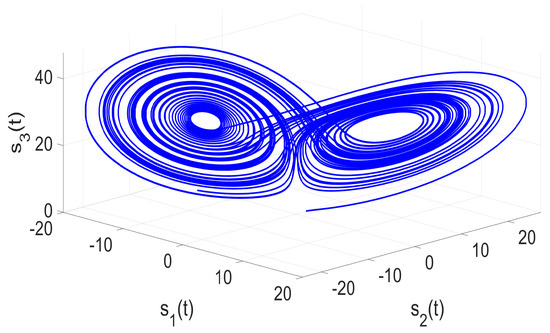
Figure 2.
The chaotic orbits of short-memory fractional Lorenz system (23).
Consider the following network:
where
Here are the corresponding Laplace matrices:
To quantify the short-memory fractional network synchronization, the synchronization mean error is defined as
Choose the coupling strengths and control gains , while the remaining nodes remain uncontrolled. Let be the identity matrix and . According to the conditions of Theorem 1, the largest eigenvalue
and
which satisfies condition (10). Therefore, the synchronization of controlled network (9) is achieved. The node errors are illustrated in Figure 3, and as shown in Figure 4, the mean synchronization errors asymptotically converge to zero across different fractional orders , demonstrating successful synchronization of system (9).
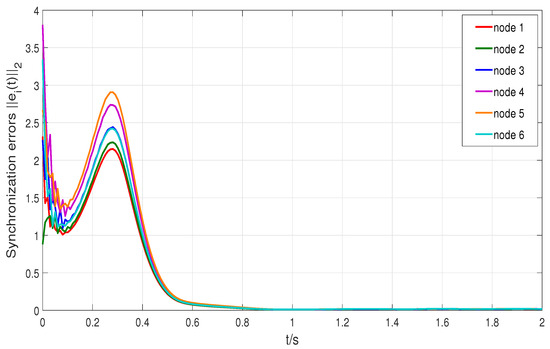
Figure 3.
Synchronization errors of network (9).
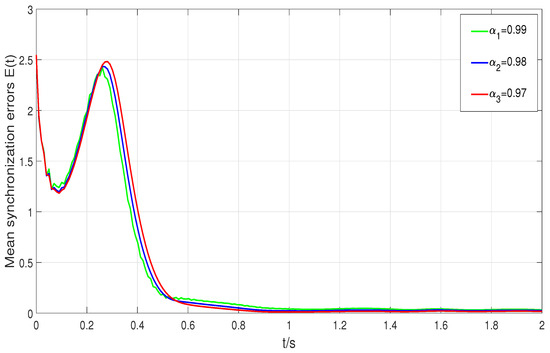
Figure 4.
Mean synchronization errors under different fractional orders .
Furthermore, the synchronization control problem for directed higher-order networks (14) is further addressed by employing an adaptive coupling strategy to enhance control efficiency. The proposed adaptive coupling mechanisms are defined as in Equation (15), with initial conditions set as for , adaptation rates of and , and all other parameters unchanged. The evolution of the adaptive coupling strengths is illustrated in Figure 5, where the coupling strengths initially start small and gradually increase until synchronization is attained. The maximum eigenvalue
confirms that condition (16) is satisfied. Consequently, the synchronization of directed higher-order network (14) is successfully achieved through the adaptive coupling strength defined in Equation (15). The synchronization errors of the nodes are shown in Figure 6, and as depicted in Figure 7, the mean synchronization error converges to zero for different fractional orders .
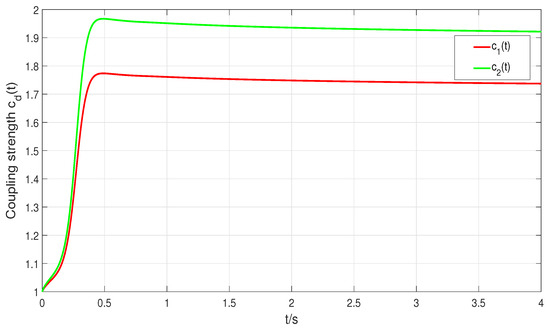
Figure 5.
The evolutionary dynamics of adaptive coupling strength (15).
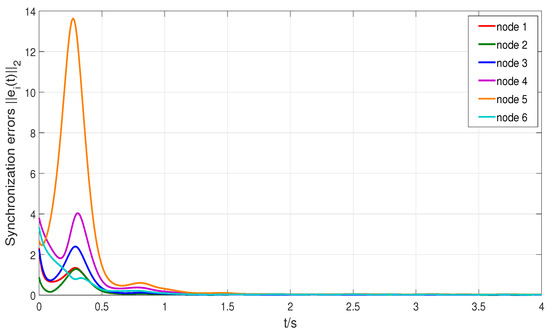
Figure 6.
Synchronization errors of network (14).
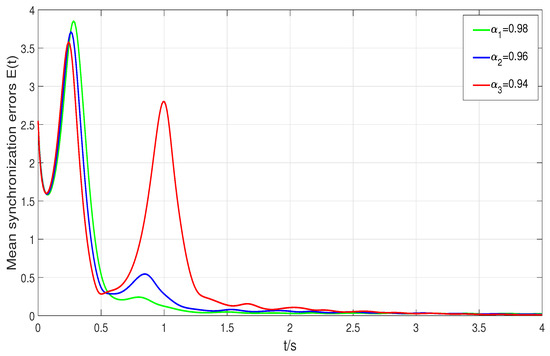
Figure 7.
Mean synchronization errors under fractional orders .
5. Conclusions
In this study, the synchronization control problem of short-memory fractional directed higher-order networks has been systematically addressed. A novel network model was constructed by integrating hypergraph theory with higher-order adjacency tensors, enabling an accurate characterization of multi-body interactions beyond traditional pairwise frameworks. Based on the short-memory property of the Caputo fractional derivative, a pinning control strategy was developed, and sufficient synchronization conditions were rigorously derived through Lyapunov function analysis and matrix techniques. These results clarify the intrinsic relationships among control gains, coupling strength, network topology, and fractional order. To enhance robustness under realistic, time-varying coupling scenarios, an adaptive control law was introduced. Furthermore, an improved predictor–corrector algorithm was proposed for general fractional systems with short memory, providing efficient numerical solutions.
The generality of the approaches developed here not only advances the study of synchronization in higher-order networks but also contributes to the broader development of short-memory fractional calculus theory. The synchronization of stochastic short-memory fractional systems will be investigated in future research to advance both theory and application.
Author Contributions
Writing—original draft preparation and methodology, X.W.; conceptualization and writing—review and editing, W.M.; software and validation, J.Z. All authors have read and agreed to the published version of the manuscript.
Funding
This work was supported by the Fundamental Research Funds for the Central Universities (Grant No. 31920230041), along with along with the 2025 Gansu Province University Graduate “Innovation Star” Program (Grant No. 2025CXZX-246).
Institutional Review Board Statement
Not applicable.
Informed Consent Statement
Not applicable.
Data Availability Statement
Data is contained within the article.
Conflicts of Interest
The authors declare no conflict of interest.
References
- Battiston, F.; Amico, E.; Barrat, A.; Bianconi, G.; de Arruda, G.F.; Franceschiello, B.; Iacopini, I.; Kéfi, S.; Latora, V.; Moreno, Y.; et al. The physics of higher-order interactions in complex systems. Nat. Phys. 2021, 17, 1093–1098. [Google Scholar] [CrossRef]
- Cencetti, G.; Battiston, F.; Lepri, B.; Karsai, M. Temporal properties of higher-order interactions in social networks. Sci. Rep. 2021, 11, 7028. [Google Scholar] [CrossRef]
- Huang, X.; Xu, K.; Chu, C.; Jiang, T.; Yu, S. Weak higher-order interactions in macroscopic functional networks of the resting brain. J. Neurosci. 2017, 37, 10481–10497. [Google Scholar] [CrossRef] [PubMed]
- Li, Z.; Ma, W.; Ma, N. Partial topology identification of tempered fractional-order complex networks via synchronization method. Math. Methods Appl. Sci. 2023, 46, 3066–3079. [Google Scholar] [CrossRef]
- Bick, C.; Gross, E.; Harrington, H.A.; Schaub, M.T. What are higher-order networks? SIAM Rev. 2023, 65, 686–731. [Google Scholar] [CrossRef]
- Battiston, F.; Cencetti, G.; Iacopini, I.; Latora, V.; Lucas, M.; Patania, A.; Young, J.-G.; Petri, G. Networks beyond pairwise interactions: Structure and dynamics. Phys. Rep. 2020, 874, 1–92. [Google Scholar] [CrossRef]
- Majhi, S.; Perc, M.; Ghosh, D. Dynamics on higher-order networks: A review. J. R. Soc. Interface 2022, 19, 20220043. [Google Scholar] [CrossRef]
- Hilfer, R. Applications of Fractional Calculus in Physics; World Scince: Singapore, 2000. [Google Scholar] [CrossRef]
- Wei, Y.; Chen, Y.; Cheng, S.; Wang, Y. A note on short memory principle of fractional calculus. Fract. Calc. Appl. Anal. 2017, 20, 1382–1404. [Google Scholar] [CrossRef]
- Lakshmikantham, V. Theory of Integro-Differential Equations; CRC Press: Boca Raton, FL, USA, 1995. [Google Scholar]
- Podlubny, I. Fractional Differential Equations; Academic Press: Cambridge, MA, USA, 1999. [Google Scholar]
- Shiri, B.; Wu, G.; Baleanu, D. Applications of short memory fractional differential equations with impulses. Discontinuity Nonlinearity Complex. 2023, 12, 167–182. [Google Scholar] [CrossRef]
- Gu, C.; Zheng, F.; Shiri, B. Mittag-Leffler stability analysis of tempered fractional neural networks with short memory and variable-order. Fractals 2021, 29, 2140029. [Google Scholar] [CrossRef]
- Wu, G.; Luo, M.; Huang, L.; Banerjee, S. Short memory fractional differential equations for new memristor and neural network design. Nonlinear Dyn. 2020, 100, 3611–3623. [Google Scholar] [CrossRef]
- Diethelm, K.; Ford, N.J.; Freed, A.D. A predictor-corrector approach for the numerical solution of fractional differential equations. Nonlinear Dyn. 2002, 29, 3–22. [Google Scholar] [CrossRef]
- Wu, G.; Deng, Z.; Baleanu, D.; Zeng, D.Q. New variable-order fractional chaotic systems for fast image encryption. Chaos 2019, 29, 083103. [Google Scholar] [CrossRef] [PubMed]
- Boccaletti, S.; Latora, V.; Moreno, Y.; Chavez, M.; Hwang, D. Complex networks: Structure and dynamics. Phys. Rep. 2006, 424, 175–308. [Google Scholar] [CrossRef]
- Chen, J.; Sun, W.; Zheng, S. New predefined-time stability theorem and synchronization of fractional-order memristive delayed BAM neural networks. Commun. Nonlinear Sci. Numer. Simul. 2025, 148, 108850. [Google Scholar] [CrossRef]
- Arenas, A.; Díaz-Guilera, A.; Kurths, J.; Moreno, Y.; Zhou, C. Synchronization in complex networks. Phys. Rep. 2008, 469, 93–153. [Google Scholar] [CrossRef]
- Skardal, P.S.; Arenas, A. Higher order interactions in complex networks of phase oscillators promote abrupt synchronization switching. Commun. Phys. 2020, 3, 218. [Google Scholar] [CrossRef]
- Saçu, İ.E. Effects of high-order interactions on synchronization of a fractional-order neural system. Cogn. Neurodyn. 2024, 18, 1877–1893. [Google Scholar] [CrossRef]
- Ramasamy, M.; Kumarasamy, S.; Srinivasan, A.; Subburam, P.; Rajagopal, K. Dynamical effects of hypergraph links in a network of fractional-order complex systems. Chaos 2022, 2, 123128. [Google Scholar] [CrossRef]
- Tatar, N.E. Stability and synchronization of a fractional neutral higher-order neural network system. Int. J. Nonlinear Sci. Numer. Simul. 2020, 21, 443–458. [Google Scholar] [CrossRef]
- Ma, C.; Ma, W.; Wang, X. Synchronization on fractional multiplex higher-order networks. Chaos 2024, 34, 103134. [Google Scholar] [CrossRef] [PubMed]
- Hai, X.; Yu, Y.; Xu, C.; Ren, G. Stability analysis of fractional differential equations with the short-term memory property. Fract. Calc. Appl. Anal. 2022, 25, 962–994. [Google Scholar] [CrossRef]
- DeLellis, P.; di Bernardo, M.; Russo, G. On QUAD, Lipschitz, and contracting vector fields for consensus and synchronization of networks. IEEE Trans. Circuits Syst. 2010, 58, 576–583. [Google Scholar] [CrossRef]
- Lu, W.; Chen, T. QUAD-condition, synchronization, consensus of multiagents, and anti-synchronization of complex networks. IEEE Trans. Cybern. 2019, 1, 3384–3388. [Google Scholar] [CrossRef] [PubMed]
- Lu, W.; Chen, T. New approach to synchronization analysis of linearly coupled ordinary differential systems. Phys. D 2006, 213, 214–230. [Google Scholar] [CrossRef]
- Golub, G.H.; Van Loan, C.F. Matrix Computations; JHU Press: Baltimore, ML, USA, 2013. [Google Scholar]
- Wang, X.; Ding, X.; Li, J.; Cao, J. Multisynchronization of delayed fractional-order neural networks via average impulsive interval. Neural Process. Lett. 2023, 55, 12437–12457. [Google Scholar] [CrossRef]
- Yu, W.; Chen, G.; Lü, J. On pinning synchronization of complex dynamical networks. Automatica 2009, 45, 429–435. [Google Scholar] [CrossRef]
- Diethelm, K.; Ford, N.J.; Freed, A.D. Detailed error analysis for a fractional Adams method. Numer. Algorithms 2004, 36, 31–52. [Google Scholar] [CrossRef]
Disclaimer/Publisher’s Note: The statements, opinions and data contained in all publications are solely those of the individual author(s) and contributor(s) and not of MDPI and/or the editor(s). MDPI and/or the editor(s) disclaim responsibility for any injury to people or property resulting from any ideas, methods, instructions or products referred to in the content. |
© 2025 by the authors. Licensee MDPI, Basel, Switzerland. This article is an open access article distributed under the terms and conditions of the Creative Commons Attribution (CC BY) license (https://creativecommons.org/licenses/by/4.0/).